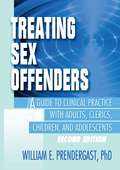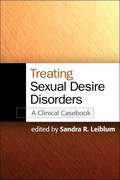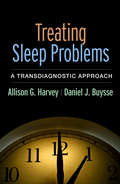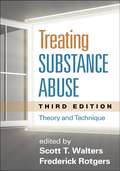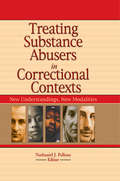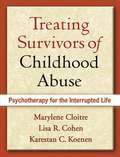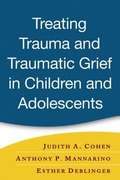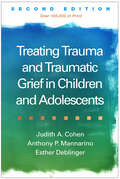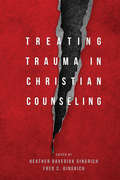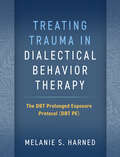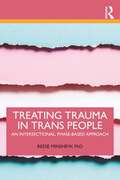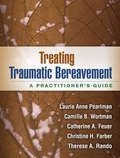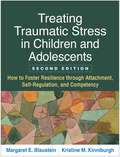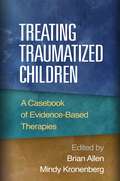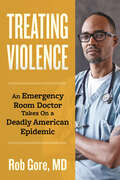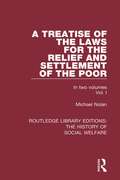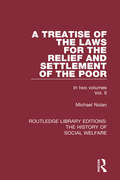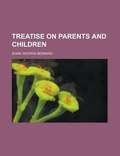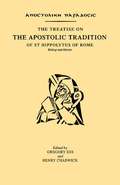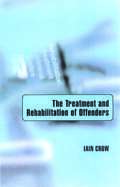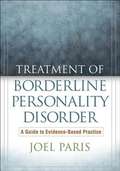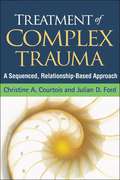- Table View
- List View
Treating Sex Offenders: A Guide to Clinical Practice with Adults, Clerics, Children, and Adolescents, Second Edition
by Letitia C Pallone William E PrendergastGain important new insights into religious personnel who molest children! Treating Sex Offenders: A Guide to Clinical Practice with Adults, Clerics, Children, and Adolescents, Second Edition updates the groundbreaking original with new material that integrates adolescent and adult sex offenders, emphasizing similarities and differences in personality type, behavior, and treatment. Author William Prendergast draws on four decades' experience in working in the diagnosis and treatment of habitual sex offenders to present a straightforward look at what makes them tick. This vital new edition includes appropriate additions and changes to treatment techniques, progress reports on case study subjects, reader feedback on the original book, and perhaps most important, new information on religious personnel who molest children. Treating Sex Offenders provides training in clear language for those working with sexual offenders and explanations in simple terms for those suffering as a result of their actions. The book parallels workshops and courses conducted by the author, detailing how to identify major characteristics and traits of offenders, different types of offenders, child and adolescent offenders, how to recognize warning signs of deviant behavior, and how to apply specific treatment techniques that really work. Individual aspects of the makeup and treatment of the compulsive adult and adolescent sex offender are addressed through factors, traits, treatment, and candid cases studies. Treating Sex Offenders addresses the most vital issues involving sexual pathology, including: inadequate personality theory sexual performance problems imprinting self-confrontation sex as the chosen deviation the five c's of sex offender treatment and much more! Treating Sex Offenders: A Guide to Clinical Practice with Adults, Clerics, Children, and Adolescents, Second Edition is an essential resource for psychiatrists, psychologists, social workers, counselors, and those in the criminal justice field who deal with sex offenders on a daily basis. Family members involved in the lives of sex offenders and survivors of sexual abuse or assault will find the case studies enlightening in making sense of a tragic situation.
Treating Sexual Desire Disorders
by Sandra LeiblumThe loss or lack of interest in sex is a common complaint in sex therapy. Organized around in-depth case presentations, this book showcases effective treatment approaches for individuals and couples. The contributors are highly skilled therapists who explore the complexity of sexual desire problems and offer detailed descriptions of clinical techniques. The book illuminates the complex interplay of biological, psychological, interpersonal, contextual, and cultural factors that need to be considered in assessment and intervention. Concise chapter introductions by editor Sandra R. Leiblum summarize key themes and provide a context for understanding each author's approach.
Treating Sleep Problems: A Transdiagnostic Approach
by Daniel J. Buysse Allison G. HarveyThis practical manual presents an innovative modular treatment for adults and adolescents with a wide range of sleep and circadian rhythm problems, such as insomnia, daytime sleepiness, poor sleep quality, and irregular sleep-wake schedules. The treatment applies broadly to all individuals with sleep problems, including those with psychiatric disorders. It is grounded in a cutting-edge understanding of sleep health and integrates elements of cognitive-behavioral therapy for insomnia (CBT-I), interpersonal and social rhythm therapy (IPSRT), and other evidence-based therapies. Each module is described in detail, including specific practitioner guidance, sample scripts, developmental adaptations, and tips for enhancing motivation. Purchasers get access to a Web page where they can download and print the book's 17 reproducible client handouts in a convenient 8 1/2" x 11" size.
Treating Substance Abuse, Third Edition
by Scott T. Walters Frederick RotgersWidely adopted, this state-of-the-art text and clinical resource captures the breadth of current knowledge about substance abuse and its treatment. For each of the major evidence-based treatment approaches, a chapter on basic assumptions and theories is followed by a chapter on clinical applications, including illustrative case material. Expert contributors cover motivational, contingency management, cognitive-behavioral, 12-step, family, and pharmacological approaches. Concluding chapters discuss effective ways to integrate different treatments in a range of clinical settings. New to This Edition, *Reflects significant advances in research and clinical practice. Chapter on the biology of substance use disorders. Chapter on an additional treatment setting: primary care. Chapter on case management.
Treating Substance Abusers in Correctional Contexts: New Understandings, New Modalities
by Letitia C PalloneGet the latest information on new and emerging modalities for treating drug-involved offenders! Treating Substance Abusers in Correctional Contexts: New Understandings, New Modalities analyzes the shift in policy and attitude away from two decades of the harsh punishment that characterized the war on drugs toward a more treatment-oriented "medicalization" of the problem. Edited by Dr. Nathaniel J. Pallone, editor of the Journal of Offender Rehabilitation (Haworth), the book presents an overview of new and emerging models for treatment of drug-involved offenders in a variety of settings. An international panel of authors examines the "rather treat than fight" approach to the war on drugs proposed by the voters of California, the Governor and criminal court judges of New York, and Gen. Barry McCaffrey, former Director of the White House Office of National Drug Control Policy. Treating Substance Abusers in Correctional Contexts looks at treatment modalities available to offenders inside and outside correctional institutions, with community organizations and mental health and social service agencies enlisted in a continuum of care as the courts and criminal justice system provide oversight-and often, funding. The book explores types of treatment that operate under the surveillance of courts and the criminal justice system, ranging from in-house programs for offenders under confinement in prisons and jails to residential substance abuse treatment (RSAT) and substance abuse treatment (SAT) programs in the community. Through qualitative, exploratory, and descriptive studies, outcome assessments, event-history analysis, and intensive interviews, the book examines recovery relapse prevention, rehabilitation, diversion, therapeutic justice, and the impact of prison-based substance abuse treatment programs. Treating Substance Abusers in Correctional Contexts also examines: the impact of deterrence versus rehabilitation on recidivism in the Drug Treatment Alternative-to-Incarceration Program (DTAP) in a major metropolitan area criminal violence and drug use in residential treatment facilities Residential Substance Abuse Treatment (RSAT) programs for young offenders the long-term effectiveness of an adult drug court program illicit drug and injecting equipment markets inside English prisons and a clinical case report on children exposed in utero to crack cocaine Treating Substance Abusers in Correctional Contexts: New Understandings, New Modalities is must reading for graduate and undergraduate courses in criminal justice, corrections, offender rehabilitation, and substance abuse. The book is equally valuable as a primary textbook for continuing education coursework for counselors, psychologists, social workers, corrections officers, correctional administrators, and policymakers.
Treating Survivors of Childhood Abuse
by Marylene Cloitre Lisa R CohenMeeting a key need, this book presents a modular adult psychotherapy approach grounded in extensive clinical experience and research. Provided is a flexible, empirically supported framework for helping clients manage symptoms related to past physical or sexual abuse; build emotion regulation and interpersonal skills; and process traumatic memories and their associated feelings of fear, shame, and loss. Session-by-session guidelines include many suggestions for tailoring interventions to each person's needs in the context of a safe, supportive therapeutic environment. Designed in a large, easy-to-use format, the book includes over a dozen reproducible handouts, worksheets, and other tools for clinicians and clients.
Treating Trauma and Traumatic Grief in Children and Adolescents
by Judith Cohen Anthony MannarinoThis is one of the first books to present a systematic treatment approach, grounded in cognitive-behavioral therapy, for traumatized children and their families. Provided is a comprehensive framework for assessing posttraumatic stress disorder, depression, anxiety, and other symptoms; developing a flexible, individualized treatment plan; and working collaboratively with children and parents to build core skills in such areas as affect regulation and safety. Specific guidance is offered for responding to different types of traumatic events, with an entire section devoted to grief-focused components. Also addressed are ways to tailor treatment to children's varying developmental levels and cultural backgrounds. The authors' approach has been nationally recognized as an exemplary evidence-based program.
Treating Trauma and Traumatic Grief in Children and Adolescents, Second Edition
by Anthony P. Mannarino Esther Deblinger Judith A. CohenThis authoritative guide has introduced many tens of thousands of clinicians to Trauma-Focused Cognitive-Behavioral Therapy (TF-CBT), a leading evidence-based treatment for traumatized children and their parents or caregivers. Preeminent clinical researchers provide a comprehensive framework for assessing posttraumatic stress disorder (PTSD), other trauma-related symptoms, and traumatic grief in 3- to 18-year-olds; building core coping skills; and directly addressing and making meaning of children's trauma experiences. Implementation is facilitated by sample scripts, case examples, troubleshooting tips, and reproducible client handouts. Purchasers get access to a Web page where they can download and print the reproducible materials in a convenient 8 1/2" x 11" size. TF-CBT is listed in SAMHSA's National Registry of Evidence-Based Programs and Practices. New to This Edition *Incorporates a decade's worth of advances in TF-CBT research and clinical practice. *Updated for DSM-5. *Chapter on the model's growing evidence base. *Chapter on group applications. *Expanded coverage of complex trauma, including ways to adapt TF-CBT for children with severe behavioral or affective dysregulation. See also the edited volume Trauma-Focused CBT for Children and Adolescents: Treatment Applications for more information on tailoring TF-CBT to children's varying developmental levels and cultural backgrounds.
Treating Trauma in Christian Counseling (Christian Association for Psychological Studies Books)
by Heather Davediuk Gingrich; Fred C. Gingrichan overview of the kinds of traumatic experiencescoverage of treatment methods, especially those that incorporate spiritualitymaterial to critically analyze as well as emotionally engage traumatheoretical bases for trauma treatment and interventionsreferences for further consideration and empirical research
Treating Trauma in Dialectical Behavior Therapy: The DBT Prolonged Exposure Protocol (DBT PE)
by Melanie S. HarnedMany DBT clients suffer from posttraumatic stress disorder (PTSD), but until now the field has lacked a formal, tested protocol for exactly when and how to treat trauma within DBT. Combining the power of two leading evidence-based therapies--and designed to meet the needs of high-risk, severely impaired clients--this groundbreaking manual integrates DBT with an adapted version of prolonged exposure (PE) therapy for PTSD. Melanie S. Harned shows how to implement the DBT PE protocol with DBT clients who have achieved the safety and stability needed to engage in trauma-focused treatment. In a convenient large-size format, the book includes session-by-session guidelines, rich case examples, clinical tips, and 35 reproducible handouts and forms that can be downloaded and printed for repeated use.
Treating Trauma in Trans People: An Intersectional, Phase-Based Approach
by Reese MinshewTreating Trauma in Trans People brings together key concepts from both gender-affirming treatment and trauma-focused care, with interventions focused on resolving physiological, intrapsychic, and interpersonal disruptions. Symptoms related to trauma and stress manifest in bodies, psyches, and interpersonal interactions. Gender, too, is impacted by bodies, psyches, and interpersonal interactions. With chapters that focus on each of these domains, this book provides a framework for clinicians eager to provide trauma-informed, gender-inclusive care. The book then broadens the lens to the systemic, acknowledging the limits of individual interventions when located within a larger framework of systemic oppression and asking clinicians to consider liberation and justice as treatment goals.
Treating Traumatic Bereavement: A Practitioner's Guide
by Laurie Anne Pearlman Camille B. Wortman Catherine A. Feuer Christine H. Farber Therese A. RandoThis book presents an integrated treatment approach for those struggling to adapt after the sudden, traumatic death of a loved one. The authors weave together evidence-based clinical strategies grounded in cutting-edge knowledge about both trauma and grief. The book offers a clear framework and many practical tools for building survivors' psychological and interpersonal resources, processing their trauma, and facilitating mourning. In a large-size format for easy photocopying, the book includes over 30 reproducible handouts. Purchasers can access a companion website to download and print these materials as well as supplemental handouts and a sample 25-session treatment plan. Winner (Second Place)--American Journal of Nursing Book of the Year Award, Psychiatric and Mental Health Nursing Category
Treating Traumatic Stress in Children and Adolescents, Second Edition: How to Foster Resilience through Attachment, Self-Regulation, and Competency
by Margaret E. Blaustein Kristine M. KinniburghTens of thousands of clinicians have used this book--now revised and expanded with 50% new material--to plan and organize effective interventions for children and adolescents who have experienced complex trauma, as well as their parents and other caregivers. The Attachment, Regulation, and Competency (ARC) framework can be used in a wide range of settings to strengthen child–caregiver relationships and support healthy development and positive functioning. Packed with case vignettes and user-friendly clinical tools, the volume identifies key treatment goals and provides flexible intervention strategies and skills. In a large-size format with lay-flat binding for easy photocopying, the book includes 79 reproducible handouts and forms. Purchasers get access to a Web page where they can download and print the reproducible materials. New to This Edition *Reflects the ongoing development of ARC, including important refinements to foundational strategies and treatment targets. *More than 30 additional handouts and worksheets; all reproducible tools are now downloadable. *Greater attention to caregiver skill development throughout. *Addresses ways ARC is being used in nontraditional settings (schools, day care, primary care practices) as well as diverse clinical contexts. See also Treating Adult Survivors of Childhood Emotional Abuse and Neglect, by Elizabeth K. Hopper, Frances K. Grossman, Joseph Spinazzola, and Marla Zucker, which presents a complementary approach also developed at The Trauma Center at Justice Resource Institute.
Treating Traumatized Children
by Brian Allen Mindy KronenbergFeaturing extensive case studies, this volume provides a unique window into implementation of evidence-based treatments in real-world community settings. Experienced therapists illustrate the use of three effective therapies for traumatized children and their caregivers: trauma-focused cognitive-behavioral therapy (TF-CBT), child-parent psychotherapy (CPP), and parent-child interaction therapy (PCIT). Covering the entire process of assessment and intervention, the cases highlight ways to maintain treatment fidelity while addressing complex clinical challenges with diverse clients. Experts in the respective therapy models offer instructive commentaries at the end of each case. The book also provides a concise introduction to each model, including its theoretical underpinnings, empirical support, and applications.
Treating Violence: An Emergency Room Doctor Takes On a Deadly American Epidemic
by Rob GoreThe inspiring story of a Black doctor who was deeply affected by the violence that plagued his Brooklyn childhood and later dedicated himself to addressing trauma and violence as public health issuesRob Gore first encountered violence when he was beaten and robbed as a 10-year old; it was treated as an inevitable fact of life, but after another brush with violence as a teen, he began to reject that prevalent attitude. As he matured and became a doctor, he grew in his determination to find treatments for what he saw not as an unavoidable fact for most people living in vulnerable, underserved neighborhoods especially, but as a public health issue that could be addressed by early intervention and solid support, beginning in the medical community. He also became deeply involved in efforts to diversify the entire field of medicine, starting with the &“front lines&” in the Emergency Department.Seeing his brother Angel and close friend Willis fall prey to the epidemic of violence with profound—and in Willis&’s case—deadly consequences, Rob began seriously researching the issue and went on to found an organization which is one of the models for successful approaches to reducing violence and protecting victims, who are disproportionately BIPOC, living in impoverished neighborhoods, or members of the LGBTQ+ community. Here he provides not only statistics, but stories of what he witnessed in NYC neighborhoods, in Atlanta, Chicago, Buffalo and even in medical work in Haiti and Kenya. His work with the Kings Against Violence Initiate (KAVI) and allied organizations is a blueprint for treating violence not as a police matter, but as a public health crisis, which can and should be addressed and substantially reduced. The people he introduces us to in these pages are not merely victims, but often advocates, paving the way for eliminating the epidemic of violence in our country.
A Treatise of the Laws for the Relief and Settlement of the Poor: Volume I (Routledge Library Editions: The History of Social Welfare)
by Michael NolanFirst published in 1805, this work summarises the vast array of laws at the time on the relief of the poor in Great Britain. Split across two volumes, it not only condenses the laws themselves but also disentangles the theory and doctrine of each law and explains how the theory should have been applied in practice. This work will be a valuable primary source for those studying 19th poor relief and welfare.
A Treatise of the Laws for the Relief and Settlement of the Poor: Volume II (Routledge Library Editions: The History of Social Welfare)
by Michael NolanFirst published in 1805, this work summarises the vast array of laws at the time on the relief of the poor in Great Britain. Split across two volumes, it not only condenses the laws themselves but also disentangles the theory and doctrine of each law and explains how the theory should have been applied in practice. This work will be a valuable primary source for those studying 19th poor relief and welfare.
Treatise on Parents and Children
by Bernard ShawChildhood is a stage in the process of that continual remanufacture of the Life Stuff by which the human race is perpetuated. <P> <P> The Life Force either will not or cannot achieve immortality except in very low organisms: indeed it is by no means ascertained that even the amoeba is immortal. Human beings visibly wear out, though they last longer than their friends the dogs.
The Treatise on the Apostolic Tradition of St Hippolytus of Rome, Bishop and Martyr
by Gregory Dix Henry ChadwickFirst Published in 1995. This book first appeared in 1937, and includes the Apostolic Tradition of St Hippolytus which is generally recognised as the single more illuminating single source of evidence on the inner life and religious polity of the early Christian Church. With a revised preface as well as the original first edition preface.
A Treatise on the Garden of Jiangnan: A study on the Art of Chinese Classical Garden
by Hongxun YangThis book presents a study into the art of Jiangnan classical garden. Jiangnan (“the south of the Yangtze River”) refers to the water network region along the lower reaches of the Changjiang River (formerly known as Yangtze River), where Jiangsu Province Chinese gardens were primarily constructed during the 16th and 17th centuries of the later Ming and early Qing dynasties. The Jiangnan garden, an architectural space where artificial and natural elements are combined, represents the elite of classical Chinese gardens and serves as a prime exemplar for its northern counterpart, the Ming and Qing imperial gardens.The book pursues an interdisciplinary approach, combining historical information with case studies and other methods. Charts and pictures are used to supplement and reinforce the conclusions drawn from the macro narrative, enhancing the authenticity and readability of the historical monographs. It represents the first study of the classical art of landscape design in China, offering readers an insightful introduction.
The Treatment and Rehabilitation of Offenders
by Mr Iain Crow`[A] useful and informative book. ...I would recommend it to students wanting a good introduction to the current issues in criminal justice and probation' - Vista: Perspectives on Probation `The three chapters on treatment in practice are all excellent; the treatment of sex offenders, mentally disordered offenders and the treatment of drug misuse are all described within the social context of public concern... Ian gives a good overview of the sex offenders' treatment program as operated in prisons and Finkelhors model which is typically used by probation in working with offenders' - Simon Bass, Caring Magazine Treatment and rehabilitation have been central to the development of criminal justice policy, and have played an important role in the development of criminology. In recent years punishment and retribution have attracted more attention than rehabilitation, but there has been a resurgence of interest in treatment and rehabilitation, with indications that some things do 'work', and an emphasis on 'evidence-based' policy making. It is also the belief of many that a penal policy without an adequate treatment strategy is unjust and a denial of human rights. In this book Iain Crow provides an accessible overview of the concepts of treatment and rehabilitation, adopting a deliberately broad definition, and considers the historical basis of treatment, and its place within the penal system and British criminology. The collapse of the 'rehabilitative ideal' is examined, along with what followed it and the development of the more recent 'what works' movement. The basis for evaluating 'what works' is also subjected to critical examination. In the second part, the book looks at the part that particular agencies such as the Probation Service, prison and non-statutory organisations have played in the treatment of offenders. In Part Three, the issues raised by treatment and rehabilitation are illustrated with reference to three groups of offenders: sexual offenders, drug misusers and mentally disordered offenders. The Treatment and Rehabilitation of Offenders will be essential reading for students of criminology and criminal justice at both undergraduate and post-graduate levels.
Treatment of Borderline Personality Disorder
by Joel Paris Alexander ChapmanNormal0falsefalsefalseMicrosoftInternetExplorer4Organizing a vast body of scientific literature, this indispensable book presents the state of the art in understanding borderline personality disorder (BPD) and distills key treatment principles that therapists need to know. Rather than advocating a particular approach, Joel Paris examines a range of therapies and identifies the core ingredients of effective intervention. He offers specific guidance for meeting the needs of this challenging population, including ways to improve diagnosis, promote emotion regulation and impulse control, maintain appropriate therapeutic boundaries, and deal with suicidality and other crises. Highly readable, practical, and humane, the book also explains the latest thinking on the causes of BPD and how it develops.
Treatment of Complex Trauma
by Julian D. Ford John Briere Christine A. CourtoisThis insightful guide provides a pragmatic roadmap for treating adult survivors of complex psychological trauma. Christine Courtois and Julian Ford present their effective, research-based approach for helping clients move through three clearly defined phases of posttraumatic recovery. Two detailed case examples run throughout the book, illustrating how to plan and implement strengths-based interventions that use a secure therapeutic alliance as a catalyst for change. Essential topics include managing crises, treating severe affect dysregulation and dissociation, and therapist self-care. The companion website offers downloadable reflection questions for clinicians and extensive listings of professional and self-help resources. A new preface in the paperback and e-book editions addresses key scientific advances. See also Drs. Courtois and Ford's edited volumes, Treating Complex Traumatic Stress Disorders (Adults) and Treating Complex Traumatic Stress Disorders in Children and Adolescents, which present research on the nature of complex trauma and review evidence-based treatment models. Winner (Second Place)--American Journal of Nursing Book of the Year Award, Psychiatric and Mental Health Nursing Category
Treatment of Complex Trauma
by Julian D. Ford Christine A. CourtoisThis insightful guide provides a pragmatic roadmap for treating adult survivors of complex psychological trauma. Christine Courtois and Julian Ford present their effective, research-based approach for helping clients move through three clearly defined phases of posttraumatic recovery. Two detailed case examples run throughout the book, illustrating how to plan and implement strengths-based interventions that use a secure therapeutic alliance as a catalyst for change. Essential topics include managing crises, treating severe affect dysregulation and dissociation, and dealing with the emotional impact of this type of work. The companion Web page offers downloadable reflection questions for clinicians and extensive listings of professional and self-help resources. See also Drs. Courtois and Ford's edited volume, Treating Complex Traumatic Stress Disorders, which presents research on the nature of complex trauma and reviews a range of evidence-based treatment models for adults.
